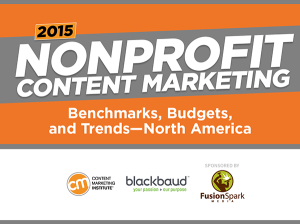Research insights to inform your 2015 nonprofit marketing plans
A new year brings new possibilities and a fresh start to your nonprofit marketing efforts. If you are looking for inspiration, two recently published research studies can help you take your digital communications strategies to the next level.
First, Blackbaud and Content Marketing Institute have once again collaborated to deliver the 2015 Nonprofit Content Marketing: Benchmarks, Budgets, and Trends – North America report.
This is the second year Content Marketing Institute and Blackbaud have partnered for this survey of 1,118 nonprofit marketers and there are a few significant developments from last year’s report.
New definitions and questions: more clarity about which organizations are true content marketers
The biggest change for 2015 is the definition of content marketing itself. Last year, the report defined content marketing as “the creation and distribution of educational and/or compelling content”. 92% of respondents said they use content marketing based on that definition. This year, the researchers updated the definition of content marketing to better reflect how it has grown: “A strategic marketing approach focused on creating and distributing valuable content to a clear audience to drive action.” With this more detailed description, only 61% of nonprofit marketers identified themselves as producers of content marketing.
The study also presented 28 initiatives and asked respondents to share if:
- They are working on them
- They are planning to work on them in the next year, or
- It is not a priority
Nonprofit marketers are working on an average of 12 initiatives or planning to work on them in the next year. The top picks were:
- Become better storytellers
- Create visual content
- Create more engaging content.
Another question that evolved from last year was the one that asked whether or not respondents had a documented content marketing strategy. Last year, researchers asked whether or not nonprofit marketers had a content marketing strategy and 54% said they did not. This led Blackbaud and Content Marketing Institute to ask the question a bit differently this year and changed it to, “Does your organization have a documented content marketing strategy” with 23% answering yes and an additional 43% responding yes, but it is not documented.
Insights for nonprofit marketers
Document your strategy
The report demonstrated that having a documented content marketing strategy is what sets successful nonprofit communicators apart from other respondents. The benefit of having a written strategy isn’t a surprise considering the amount of content nonprofit communicators are producing:
- 48% of respondents say they publish new content daily or multiple times per week.
- The average number of audiences a nonprofit marketer is trying to reach is four.
That is four different audiences with separate content marketing strategies for each. Those with a written document were more likely to follow their content marketing strategy very closely – which makes them more effective nonprofit marketers. They also were more likely to identify themselves as being successful in tracking their content marketing ROI.
Maximize social media
Although ROI is important, the majority of respondents (87%) agreed that brand awareness is the most important goal of content marketing. Social media (excluding blogs) is the top choice for content marketing tactics but on average, nonprofit marketers are using 12 different online tactics. Breaking down social media usage:
- Facebook is still the preferred platform followed by Twitter and YouTube
- Instagram had the biggest increase (17% last year vs 38% this year)
- Facebook is also listed as the most effective social media tactic
- The biggest increase in this category was with SlideShare (24% last year vs 38% this year)
Nothing beats face-to-face
Even though social media tops the list of tactics, in-person events are rated as the most effective tactic to reach your audience. 55% of respondents say increased event participation is the most important metric an organization uses to assess their content marketing strategy. This was a new choice on the 2015 survey. Other popular metrics were website traffic and increased fundraising.
Purchasing media pays off
Although 69% of nonprofit marketers surveyed confirmed they are creating more content than they were last year, unfortunately, their budgets have not increased over last year. However, this has not stopped us from buying advertising space to distribute content. In fact 83% responded they are buying advertising space in print media to get their messages out.
- Asking which paid advertising methods an organization uses was a new question this year.
- The average number of methods used was three and included promoted posts, social ads, SEM (search engine marketing) and banner ads.
- SEM was rated as the most effective paid advertising method.
- The average percentage of an organization’s total marketing budget spent on content marketing was 23% and 37% responded they will increase this spending in the next 12 months. This isn’t a surprise since 56% feel the lack of budget is the biggest challenge they face, followed closely by measuring content effectiveness.
Don’t neglect your website
The second report comes from Good Works, who surveyed 516 nonprofit marketers in 2014 and published their findings in 2014 State of the Nation: Website Benchmarks for Canadian Charities. Their big discovery is charity websites are not delivering when it comes to donor expectations.
- 49% of respondents admitted their website is filled it with content that they wanted to promote.
- Only 38% stated they created their website based on what they thought their audience wants to see.
State of the Web Nation also concurs with the Blackbaud report that organizations need a strong documented strategy (only 46% of respondents have a documented website strategy). They also agree that nonprofit marketers need:
- Bigger budgets
- To tell better stories
- To better track their online content (only 18% felt they were doing a good job measuring their KPIs and other goals)
In addition to the survey results, the Good Works report also includes lots of great suggestions and analysis about topics they find particularly noteworthy. Here are the top five takeaways I got from the report:
- Your donation page is more than a digital cash register. Use the space to inspire people to give.
- Google algorithms are getting smarter, so make an effort to update your website frequently.
- You should know what content management system is powering your website and your best choice is open-sourced CMS software.
- Implementing search engine optimization (SEO) is more work but it will increase traffic to your website.
- Your website should be mobile friendly. This isn’t an option anymore.
Now that you are up on the big ideas and trends for 2015, make this year matter by putting as many of these game-changing concepts in action. After all, it is what your competitors are doing – or should be doing. Implementing these changes could dramatically improve your nonprofit marketing strategy and help make 2015 your best year yet.



 PRINT
PRINT


